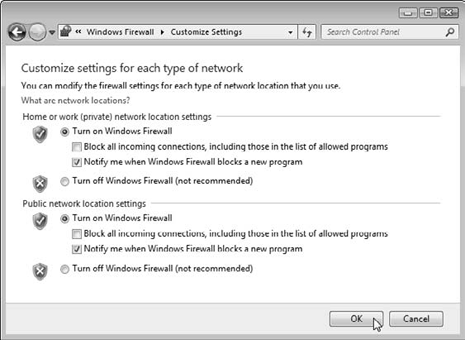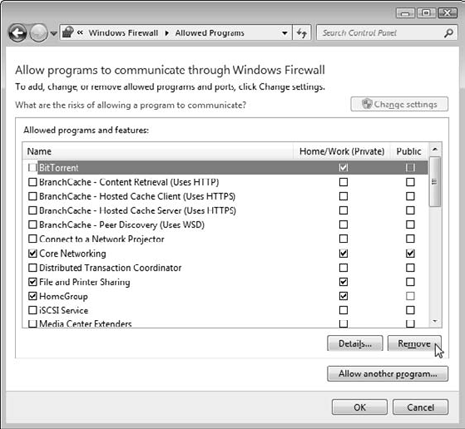Tasks in this chapter
Turning on (or off) Windows 7 Firewall
Allowing or stopping a program from poking through Windows 7 Firewall
Manually changing Windows 7 Firewall settings
Even if you're not using a traditional network in your home or office, you're exposed to a network nearly every day. The Internet is a vast network connecting computers around the world. And those connections come with dangers.
See, your computer opens a door to the Internet whenever it asks for information. And naturally, because your computer needs to receive information — a Web page, for example — the computer holds that door open.
Unfortunately, some people make a habit of looking for open doors and trying to sneak in when nobody's looking. Why? For some people, the childish thrill of seeing if they can snoop around in Jeff's locker without getting caught is just too tempting to resist.
Others sneak in like burglars, looking for credit card numbers, e-mail addresses, or other private files. Still others are vandals, destroying whatever they get their hands on. The business-minded crooks quietly take over computers, and then sell them to spammers, who surreptitiously crank out junk mail, all unnoticed by the computer's owner.
Simply put, your computer needs somebody to stand guard at the door, opening and closing the door at the right times to filter out the bad folks.
A firewall is that security guard, and this chapter explains how to turn on Windows 7's built-in firewall, how to let the right programs through, and how to keep the bad ones out.
Every version of Windows 7 includes a built-in firewall. Like Windows Vista, Windows 7 turns on its firewall automatically.
To see for yourself that Windows 7's firewall is running — and to turn it on if it's accidentally turned off — follow these steps:

Click the Start menu, and choose Control Panel. When the Control Panel appears, click System and Security.

From the System and Security window, choose Windows Firewall. Then, from the Windows Firewall window's left pane, choose Turn Windows Firewall On or Off. The Windows Firewall's Customize Settings window appears, showing the firewall's current settings: On or Off.
Make sure the firewall is listed as On in both network areas, Public and Home or Work. This keeps your computer the safest. The two sets of settings let you customize the firewall's settings differently depending on whether you're connected to a "public" or "home or work" network.

If you want to turn off the firewall, click Turn Off Windows Firewall (Not Recommended) in the Home or Work area. (Always leave the firewall turned on in Public.) Then click OK to save your settings. Turn off the firewall only as a last resort while troubleshooting a network connection. When you're through troubleshooting, turn the firewall back on, or you'll be unprotected.
Tip
If you install a third-party firewall, it will automatically turn off Windows' built-in firewall. (Firewall programs interfere with each other, so you should run only one firewall.)
Although firewalls offer protection, they can be as annoying as an overzealous airport security scan. In their zest for security, firewalls sometimes stop programs that you want to work. If you find one of your newly installed programs being denied Internet access, here's how to handle the situation:
Run or install a new program. If the program accepts or makes an unexpected Internet connection, Windows 7 stops the program from connecting, and immediately sends you a Windows Security Alert.

If you spot that window and you haven't tried to run a program, click the Cancel button: You've effectively stopped what could be a rogue program from connecting with the Internet. But if you're trying to install a program that needs to connect with the Internet, click the Allow Access button, instead. Windows 7 Firewall adds that program to its exceptions list and no longer bugs you about it.
On a rare occassion, you'll need to delve deeper into the firewall's settings. You may need to remove a previously approved program, for example, or add a new program to the "Good Guys" list.
To change the firewall's list of programs, follow these steps:

Choose Control Panel from the Start menu, and click System and Security.
From the Windows Firewall section, choose Allow a Program through Windows Firewall. The Windows Firewall Settings window opens to show every program currently allowed or forbidden to cross the firewall. Programs with a checked box are able to accept incoming connections through the firewall. No checkmark in a program's box? Then that program may connect to the Internet, but not accept incoming connections.

To remove a program you've mistakenly approved, click the program's name, click the Remove button, and click Yes. To add a program, click the Allow Another Program button and choose your program from the list. Not listed? Then click Browse to browse to the program's name. (Hint: Programs live in your C: drive in the Program Files folder.) Then save your changes by clicking the OK button.

Tip
Think you've messed up your firewall settings? In Step 2, click Windows Firewall, and then click Restore Defaults from the left pane. That removes any changes you've made to the firewall, leaving it set up the way it was when first installed. (Clicking Restore Defaults may also keep some programs from working until you add them to the Exceptions list again.)
